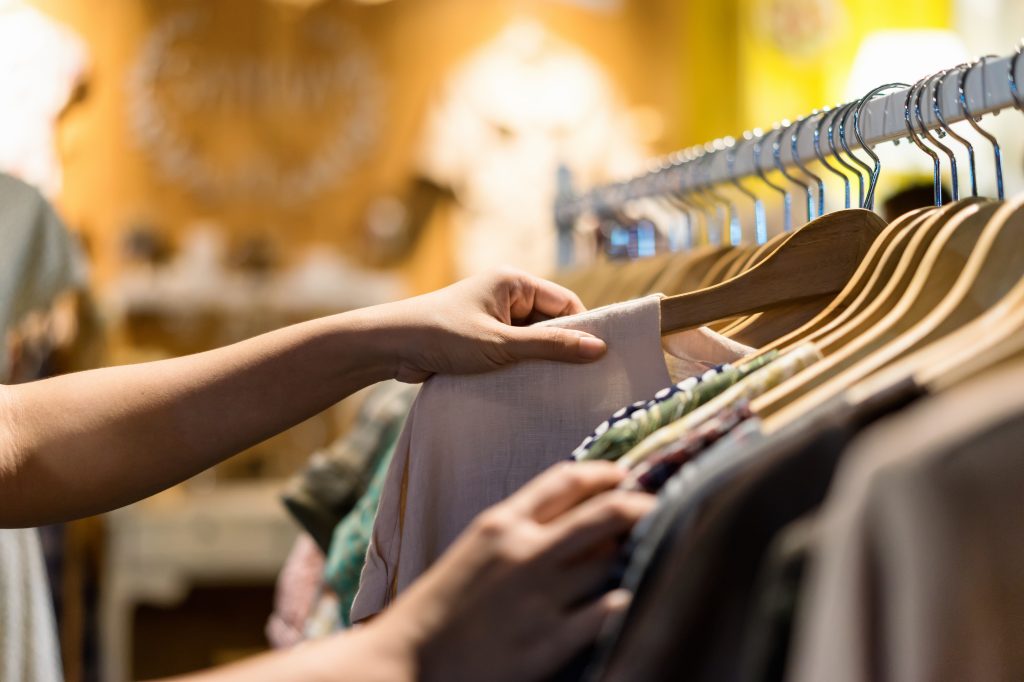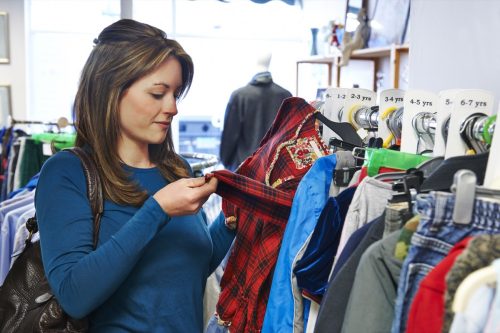How to Find Treasures at Thrift and Secondhand Stores
If you're looking to locate unique or valuable items, check out these quick tips.

Those looking to hit the racks at thrift and secondhand stores usually do so in the hopes of finding a good deal on a rare brand or even coming across something that could make them rich. Of course, opting to go the vintage route when shopping can add a lot of work to the process. But just as with looking for worthwhile finds at any major retailer, a little extra knowledge can get you a real leg up in your secondhand search. Read on for expert tips on how to find treasures at thrift and secondhand stores.
RELATED: 7 Ways to Spot Fake Deals and Scams When Online Shopping.
1
Start with the clearance rack.

If you're at a secondhand store, it might feel counterintuitive to seek out items that are even further discounted. But according to Vivian Kelly, vintage clothing and fashion expert, the clearance section is where you should head first even when you're thrifting.
"I always start with the clearance rack," Kelly tells Best Life. "I've found some true hidden gems on these racks simply due to others not knowing what they're looking for."
Andrea Woroch, money-saving and lifestyle-budgeting expert, agrees, adding that these items have likely been on the racks for a while. "These are items that haven't sold within a certain period of time and have been marked down," she says, meaning that you might score a rare find and pay even less.
2
Know where you're looking.

City dwellers will be disappointed to learn that they may have to travel to locate certain treasures. According to Deepak Tailor, founder and CEO of the website Latest Free Stuff, smaller thrift stores can be goldmines.
"Small-town thrift stores are the best kinds to shop from, and any lesser known stores," he explains. "Secondhand stores in larger cities, and big brand name shops, tend to be very overpriced, and they don't have as many unique items."
These more localized shops are not only more affordable but also more likely to have the "one-of-a-kind" pieces you're seeking, Tailor says.
However, if you are working with what's available in a bigger city, it can help to target specific areas.
"The most amazing find I scored was at a thrift store in a warehouse distribution area where most shoppers were looking for the newest items and passing over classic vintage pieces," says Brenda Christensen, CEO of Stellar Public Relations and former owner of Los Angeles vintage clothing store Vintage Diva. "I found a pair of Chanel high-top sneakers for mere dollars and sold them online for $1,000 to a buyer in Paris."
RELATED: 6 Best Clothing Items to Buy at Thrift Stores, Stylists Say.
3
Try to beat the crowds.

Many shoppers plan to show up early to major sales events at traditional stores to ensure they get the items they're after. But in one-off shopping situations like thrift and secondhand stores, it can especially pay off to be the early bird.
"Although most thrift stores add new items throughout the day, heading there first thing in the morning means that things are more organized, and you'll be the first to see if anything new has been put out on the floor," says Jennifer Prince, owner and merchandiser at It's Found Vintage.
Of course, it can also pay to get a feel for how the store operates by visiting often in general.
"The more often you go, the more you learn when they bring out new merchandise, what their sale days are—and in some cases, which days they don't restock," says Willow Wright, owner of Urban Redeux in Alexandria, Virginia. "For example, a local store near me doesn't restock on Mondays because everything is 25 percent off on Tuesdays."
4
Don't ignore items—even if they look like they're ripped or damaged.

If you see something that's broken at the mall or grocery store, odds are you're going to leave it on the shelf and maybe let an employee know. But if you see something in disrepair at a thrift shop, it could just be your lucky day.
"You can also purchase pieces that need repair if you know what repairs cost," Kelly says, noting that you should first locate a reputable repair shop.
Sometimes, however, items are just past their prime—and you'll have to make the final call. "If an item is simply too worn out, it may be best to just pass on it," Kelly adds. "Clothing does indeed have a shelf life."
5
Use your phone.

Most of us don't leave home without our smartphones, and you'll want to make extra sure you have yours when you're thrift shopping, according to experts.
"Always have your phone on hand when searching through secondhand stores," Tailor says. "You can easily look up items you might think are valuable and see what they go for online."
You'll then have a better idea of whether the price tag is a good deal, regardless of whether you keep the item for yourself or resell it, he adds.
RELATED: 6 Thrifting Hacks from Ex-Goodwill Employees.
6
Make friends in the right places.

If you've already secured a reliable secondhand shop, Kelly recommends befriending the owners.
"They will then let you know in advance when something good comes in," she says, adding that you can return the favor and "spread the word" about their shop.
"I also let the owners know what I'm looking for, and they will then keep this in mind when they are buying items for their inventory," Kelly explains.
Not getting much out of the staff? It can also help to get to know your fellow shoppers.
"I would suggest making friends with people who walk into the store while you're there," says Mikara Reid, personal style consultant at MIIEN. "They may be trying to sell stuff to the store or know other spots to shop at."
7
Don't rule out online shopping.

Thrift stores often conjure images of crowded, multicolored racks—and maybe even a certain smell. But if you don't like the hustle and bustle of shopping in person (or just like to save time), you can search for treasures without leaving your house.
"Skip spending hours searching through stores and look online," Sierra Skelly, editorial manager at GoodBuy Gear, an online children's consignment store, recommends. "There are a ton of secondhand shopping options online now."
RELATED: 6 Fabrics Stylists Say They'll Never Wear.
8
Know what you're looking for.

The very nature of thrift and secondhand stores can make even the most organized shops feel a little chaotic. That's why it can help to have a plan before you start perusing the racks.
"Of course, I go into every thrift store with an open mind, but I also find that keeping a list or popping in looking for a specific item can be really helpful," says Prince. "Instead of meandering, looking for anything and everything, I often find exactly what I need when I'm more focused on my list."
As part of your organizing and planning, it can also help to have vital information on hand to help you narrow down your choices.
"If you're looking for something specific, whether a pair of pants or a piece of art or furniture, know your required dimensions before you leave home," suggests Wright. "A quick note on your phone will help you out a lot later. Bring a tiny tape measure—or if you're lucky, you may even find one in the tool area!"
9
Look for stores that sell "open box items."

Speaking of online shopping, there's another benefit to it, Skelly says. There are certain key phrases any thrifter should be aware of. If you hear that a consignment shop sells "open box items," it should be music to your ears.
"These are basically floor models and returns from high-end retailers," Skelly says. "They're just like new, but half the price!"
These deals are often available online through third-party retailers, who resell the opened items at a lower price, she explains.
RELATED: 6 Classic Clothing Items That Never Go Out of Style, Fashion Experts Say.
10
Time your shopping dates right.

Those looking for deals on new fashion tend to follow the sales cycle to help ensure the best deals. But experts say there's a bit of a trickle-down effect on secondhand stores that can be advantageous to those in the know.
"The best time of the year to go thrifting is post-holiday in January," Christensen tells Best Life. "People have gotten new items for Christmas or Hanukkah and are getting rid of things they don't want that are brand new or replacing items."
But there's no reason to limit yourself to just one season. Other events in the year can also bring great finds to your local go-to shop.
"Spring is another great time when people are hauling their unwanted items to the thrift store during spring cleaning rituals," she says. "And surprisingly, late fall is also good, as back-to-school prompts many to get a fresh wardrobe and declutter before the holidays."
11
Become an expert in your field of interest.

There's a big difference between knowing what you want and knowing what to look for out there. That's why experts say a bit of expertise can go a long way in the world of thrifting—especially if you're trying to land a true rarity or big-ticket item.
"Regardless of whether you thrift for home decor, clothing, or even books, it's important to spend some time learning about what you're interested in finding," says Wright.
She says that as a home furnishings and decor market reseller, she spends hours poring over art and design books, both current and past.
"Having an eye for finding treasures sometimes comes naturally, but there are ways to train it," she says. "Eventually, you'll start to recognize works by certain artists, pottery companies, lamp manufacturers, and vintage fashion designers."
This story has been updated to include additional entries, fact-checking, and copy-editing.





















